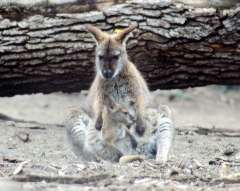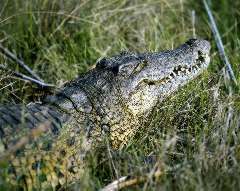Kangaroos
Australia’s Kangaroos are native to the Australian continent and to parts of Papua New Guinea. There are over 60 different species of kangaroo most of them in Australia.
There are no accurate figures for population numbers of kangaroos, but the current number is the highest ever recorded. Four of the 48 species can now be commercially harvested and their numbers are estimated to be 50 - 60 million.
All kangaroos belong to the super-family Macropodidae (or macropods, meaning ‘great-footed').
The different kangaroo species live in diverse habitats from cold-climate rainforests to desert plains to tropical areas.
Kangaroos are herbivorous and eat a range of plants and some fungi.
Most are nocturnal but some are active in early morning and late afternoon.
All kangaroos of all sizes have one thing in common, powerful back legs with long feet.
The kangaroo’s tail is used to balance while hopping and to steady itself when moving slowly.
In the breeding season, usually spring and early summer, rival male kangaroos rear up on their hind legs and box to compete for a female.
The baby kangaroo, or ‘joey’, is born after a gestation of 29 – 38 days.
The joey measures only 2.5cm in length and weighs less than 1g when it is born. It manages to drag itself up to the pouch, were it lives for the next 300 days drinking milk.
After 15 weeks the joey has grown considerable bigger but continue to stay in the pouch for another 6 months.
Most kangaroos have no set breeding cycle and are able to breed all year round.
A kangaroo population can increase fourfold in five years if it has plentiful supplies of food and water.

Aborigines have hunted the kangaroo for tens of thousands of years, for their meat and skins.
All Australian States and Territories have legislation to protect kangaroos.
European farming methods have dramatically increased the number of kangaroos leading to excessive grazing pressure on the vulnerable Australian environment. Kangaroo population management is vital for the protection of some habitats and the survival of other native animals.
Kangaroos are culled by licensed hunters.
The Wildlife Protection (Regulation of Exports and Imports) Act 1982, which had prevented the export of live kangaroos was repealed in 2001.
Freshwater Crocodiles
Freshwater Crocodiles can be found throughout the coastal and inland regions of northern Australia, from Western Australia to Queensland.
They are usually found upstream in rivers but can tolerate some saltwater. Their main habitats include wetlands, rivers, creeks and swamps, and they do not mind still water, fast flowing, muddy, shallow or deep water.
At the end of the wet season freshwater crocodiles usually move to more permanent water.
Mating occurs in the dry season during July, and nesting occurs over a two or three week period during August.
Freshwater crocodiles dig hole nests in sandy river banks. As the eggs are close to the ground water table, they are more susceptible to flooding at the start of the wet season.
Females tend to return to the same nesting sites year after year.
The female crocodile is not a good defender of her eggs. Almost 80% of nests are destroyed by predators such as monitor lizards and pigs.
The average size of the clutch is around 13 eggs. The largest clutches are laid at the start of the nesting period. The incubation period is around 74 to 80 days depending upon the outside temperature.
The sex of the baby crocodile is determined by the temperature during incubation. For example mostly males will be born if the temperature is between 31 and 32 degrees Celsius. If the temperature is warmer or cooler than 31 and 32 degrees Celsius the mostly females will be born.
Hatchlings weigh about 42 grams and measure about 24 cm at birth. They have one small tooth which that they use to split the egg to get out, and are often helped by their mothers. The mother will then carry the hatchlings to the water in her mouth. The mother stays with her little nursery of hatchlings for a few weeks.
The hatchlings’ rate of survival is less than 1% as birds, other crocodiles, turtles and large fish prey on both eggs and hatchlings.
Juvenile crocodiles eat insects, shellfish and small fish. Large adults prey on other reptiles, bats, birds and amphibians.
Freshwater crocodiles hunt by waiting at the water’s edge for prey to come within range. They do not hunt on land.
Freshwater crocodiles swallow small stones that help with digestion.
Crocodiles vary in size and are largely influenced by environment, habitat, genetics and diet. Males can reach from 2.4 to 3 metres and can weigh up to 53kg. Females are usually smaller getting to about 2 metres in length. It takes juvenile crocodiles about 20 years to reach their maximum size. Males reach sexual maturity at around 16-17 years and females at 11 – 14 years.
Freshwater crocodiles live for about 50 years.
The biggest threat to freshwater crocodiles is loss of habitat to farming or development.
Freshwater crocodiles only become dangerous when they are teased or irritated.
Estuarine Crocodiles
Estuarine crocodiles are distributed throughout the coastal regions of northern Australia, from Broome in Western Australia to Rockhampton in Queensland.
It is found primarily in mangrove-lined tidal rivers up to 200 km from the coast, in creeks and freshwater swamps up to 100 km from the coast.
Adults have even been found swimming 1000 km out to sea.
Estuarine crocodiles can be found basking on the exposed mud of tidal riverbanks during cooler months, but in the summer spend their time in the water and shade coming out to hunt at night.
Saltwater crocodiles are found in higher densities where there are good nesting sites and lots of food.
Hatchlings are born with very sharp teeth and will begin feeding almost immediately. Juveniles will take a wide variety of small prey such as insects, shellfish and small fish. Adult saltwater crocodiles will take dingos, wallabies, shore birds, other crocodiles, large reptiles, domestic animals, cattle and even people.
Their teeth are designed for holding rather than cutting and they help to crush the prey with their incredibly powerful jaws. Large prey is broken into small pieces by a violent flick of the head, or a twisting/rolling action of the body.
Swallowing must occur above the water surface, or water will flood the lungs.
The estuarine crocodile will wait close to the water’s edge and pounce upon prey which ventures too close.
Estuarine crocodiles lay between 40 and 60 eggs depending on the size and age of the female. The eggs weight around 113 grams and measure 80 mm x 50 mm. Estuarine crocodile hatchlings weigh around 72 grams and measure 29 cm in length.
The biggest estuarine crocodile ever documented was 7 metres long, and over 1000 kg in weight. The average size is 5 to 6 metres.
Males live to at least 70 years and possible even 100 years old.

Growth generally continues throughout life, but is much slower in older animals.
Large crocodiles can be aged by the number of growth rings in their bones.
Unregulated hunting up the 1970s brought the estuarine population to the brink of collapse. But in 1971 (and 1974 in Queensland) saltwater crocodiles have been protected allowing the population to show an excellent recovery rate.
Most attacks by crocodiles occur in the wet season, when they do most of their feeding and growing. In general crocodiles do not attack fishing boats and there have been 14 deaths caused by crocodiles throughout Australia in the last 27 years.
Spiny Anteater
The spiny anteater is a monotreme. Monotremes are a type of egg-laying mammal.
The spiny anteater can only be found in Australia, Tasmania and parts of New Guinea.
Spiny anteaters are most active at night, except when the weather is cold.
The spiny anteater has a good sense of smell and is also known as the short nosed echidna (which is the more common variety).
It can easily demolish a termite mound in an attempt to reach its favourite food. It mostly eats termite ants and other small invertebrates, which it grinds up in its mouth with specially adapted spines instead of teeth.
The spiny anteater is round and covered in closely set spines – a bit like a giant hedgehog.
When threatened, the spiny anteater will roll itself into a ball, exposing its sharp spines.
The female give birth to a single, sticky egg in a specially formed ‘pouch’, called the incubatorium, where it hatches seven to ten days later. The pouch is not permanent and only develops once the egg has been fertilised. The egg is leathery unlike a bird’s egg.
When the baby is born it is blind and hairless and only 1.25 cm long. The baby stays in the pouch until its spine is fully formed – about 3 weeks later and then it leaves the pouch.
Spiny anteaters grow to 36 to 99 cm long with a 10cm long tail.
Spiny anteaters can live for over 50 years.
Kookaburras
Kookaburras can only be found in Australia.
There are two types: the laughing kookaburra and the blue-winged kookaburra.
The laughing kookaburra is mostly found in the bushlands of Eastern Australia whilst the blue-winged kookaburra is found in mangrove swamps in the Northern Australia.
Kookaburras can live for 20 years or more in the same family groups. They pair for life and build their nest in a hole of their favourite tree.
An adult female kookaburra becomes sexually mature at one year, and will lay between one and six blue-green blotched eggs in a season with an average of four eggs to a nest. The eggs are kept warm for 25 days before they hatch.
The babies are fed by both the mother and father, and stay with their parents for four years.
Kookaburras have good eyesight and are fierce hunters. Their favourite foods are lizards and snakes but it also eats insects, earthworms, fish, frogs and toads, mice, rats and other rodents. They kill their prey by beating it against a rock, then pound it with their beak to soften the meat making is easier to eat.
The kookaburra eats its prey whole sometimes having to rest for lengths of time waiting for the first half of the animal to be digested so the second half can be swallowed. The Kookaburra can then regurgitate food and store it in the nest for future meals. The laughing kookaburra, also known as the laughing jackass, is the largest member of the kingfisher family. It got its name from its distinctive laugh, and can be heard at sunrise and at sunset.
They have about six different calls, each signalling something different to the family or intruders.
It is mostly coloured brown with some black barring on its wing and tail feathers. The fluffy head and chest are a whitey-grey colour. A small amount of bright blue can be seen on its wings.
The blue-winged kookaburra is smaller than its cousin the laughing kookaburra.
It lives in the mangrove swamps of Northern Australia and has a preference for aquatic food such as fish, freshwater crayfish, frogs, waterworms and small crabs.
It has a call like a barking cough.
The head and chest are fluffy and covered with light coloured feathers, the rump and wings are coloured bright blue and it has some brown feathers above its dark blue tail.
Credits
Image: australian-wildlife-part-2 by David Cook
Information sourced from:
Australian Wildlife Society (2015), Frequently Asked Questions [online], available from: http://www.australianwildlife.net.au/faq.html [accessed 21/05/2015]
Australian Government ComLaw, Environment Protection and biodiversity Conservation Amendment (Wildlife Protection) Act 2001 [online], Available from: http://www.comlaw.gov.au/Details/C2004A00849 [accessed 21/05/2015]



